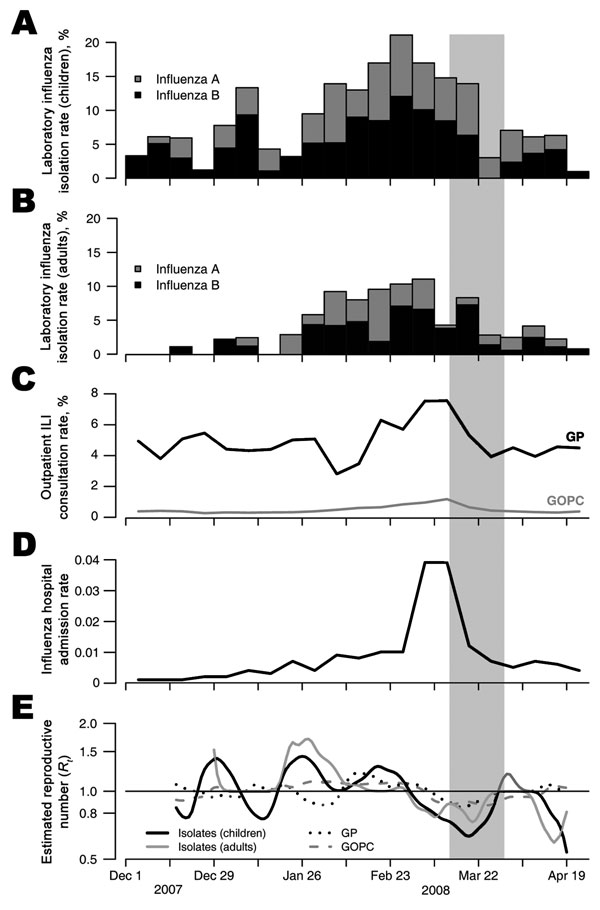Volume 14, Number 10—October 2008
Dispatch
Effects of School Closures, 2008 Winter Influenza Season, Hong Kong
Figure

Figure. Influenza surveillance data from December 1, 2007, through April 26, 2008, including the 2-week school closure period (gray vertical bar): A) Proportion of influenza A and B isolations (by date of collection) among all children’s specimens that were submitted to the World Health Organization (WHO) reference laboratory at Queen Mary Hospital (most specimens are referred from local hospitals). B) Proportion of influenza A and B isolations (by date of collection) among all adult patients’ specimens that were submitted to the WHO reference laboratory at Queen Mary Hospital. C) Weekly influenza-like illness (ILI) (defined as fever plus cough or sore throat) consultation rates in sentinel networks of outpatient clinics in the private (GP) and public (GOPC) sectors. D) Weekly rates of public hospital admissions in young children (<4 years) with a principal diagnosis of influenza (International Classification of Diseases, 9th revision, code 487), where the denominator is the general population of the same age. E) Daily estimates of the effective reproductive number based on the laboratory and sentinel outpatient data. Source for panels B–D (7).
References
- Russell CA, Jones TC, Barr IG, Cox NJ, Garten RJ, Gregory V, The global circulation of seasonal influenza A (H3N2) viruses. Science. 2008;320:340–6. DOIPubMedGoogle Scholar
- Wong CM, Chan KP, Hedley AJ, Peiris JS. Influenza-associated mortality in Hong Kong. Clin Infect Dis. 2004;39:1611–7. DOIPubMedGoogle Scholar
- Cowling BJ, Wong IO, Ho LM, Riley S, Leung GM. Methods for monitoring influenza surveillance data. Int J Epidemiol. 2006;35:1314–21. DOIPubMedGoogle Scholar
- Lau EH, Cowling BJ, Ho LM, Leung GM. Optimizing the use of multi-stream influenza sentinel surveillance data. Emerg Infect Dis. 2008;14:1154–7. DOIPubMedGoogle Scholar
- Parry J. Hong Kong closes all primary schools in flu outbreak. BMJ. 2008;336:632. DOIPubMedGoogle Scholar
- Expert Group on Investigation of Flu Deaths in Children. Report on the investigation of acute febrile deaths in three children during the 2008 seasonal influenza outbreak in HKSAR: summary and recommendations [cited 2008 May 2]. Available from http://www.chp.gov.hk/view_content.asp?lang=en&info_id=12150.
- Centre for Health Protection of the Government of the Hong Kong SAR. Flu express. May 9, 2008 [cited 2008 May 10]. Available from http://www.chp.gov.hk/files/pdf/FLU_EXPRESS_Wk_18_2008.pdf. 2008.
- Lowen AC, Mubareka S, Steel J, Palese P. Influenza virus transmission is dependent on relative humidity and temperature. PLoS Pathog. 2007;3:1470–6. DOIPubMedGoogle Scholar
- Wallinga J, Teunis P. Different epidemic curves for severe acute respiratory syndrome reveal similar impacts of control measures. Am J Epidemiol. 2004;160:509–16. DOIPubMedGoogle Scholar
- Cowling BJ, Fang VJ, Riley S, Peiris JSM, Leung GM. An estimate of the serial interval of influenza using laboratory-confirmed natural infections in households. Epidemiology. 2008. In press.
- Cowling BJ, Ho LM, Leung GM. Effectiveness of control measures during the SARS epidemic in Beijing: a comparison of the Rt curve and the epidemic curve. Epidemiol Infect. 2008;136:562–6. DOIPubMedGoogle Scholar
- Cauchemez S, Valleron AJ, Boelle PY, Flahault A, Ferguson NM. Estimating the impact of school closure on influenza transmission from sentinel data. Nature. 2008;452:750–4. DOIPubMedGoogle Scholar
- Flahault A, Letrait S, Blin P, Hazout S, Menares J, Valleron AJ. Modelling the 1985 influenza epidemic in France. Stat Med. 1988;7:1147–55. DOIPubMedGoogle Scholar
- Heymann A, Chodick G, Reichman B, Kokia E, Laufer J. Influence of school closure on the incidence of viral respiratory diseases among children and on health care utilization. Pediatr Infect Dis J. 2004;23:675–7. DOIPubMedGoogle Scholar
- Longini IM Jr, Halloran ME. Strategy for distribution of influenza vaccine to high-risk groups and children. Am J Epidemiol. 2005;161:303–6. DOIPubMedGoogle Scholar